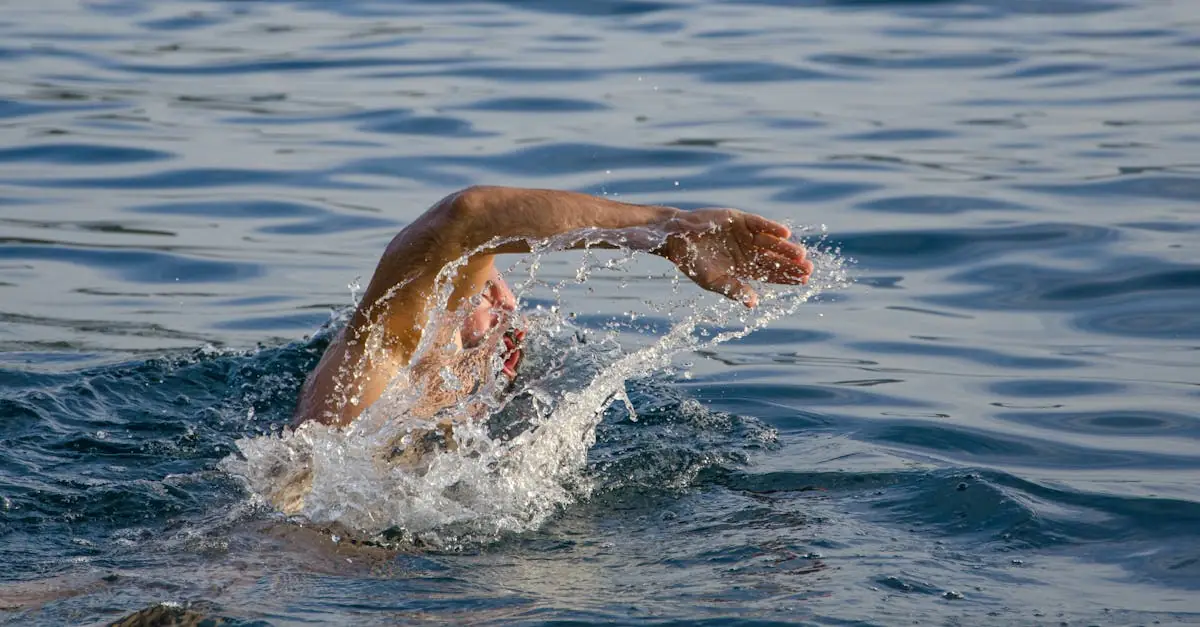Triathlons are the ultimate test of endurance, combining swimming, cycling, and running into one heart-pounding event. For those ready to tackle this challenge, a solid training plan is essential. It’s like having a GPS for your fitness journey—without it, you might just end up lost in a sea of sweat and confusion.
Table of Contents
ToggleOverview of Triathlon Training Plans
Triathlon training plans structure the preparation process for athletes competing in multi-discipline races. Plans vary based on race distance, experience level, and individual fitness goals. Most commonly, three distances define triathlon events: sprint, Olympic, and Ironman. Each distance requires unique approaches to training.
Sprint triathlons feature the shortest distances, typically comprising a 750-meter swim, 20-kilometer bike ride, and 5-kilometer run. Training for this event focuses on speed and efficiency, often emphasizing short, high-intensity workouts. Olympic distances, on the other hand, double these figures and demand additional endurance work.
Ironman distances significantly elevate the challenge, including a 3.8-kilometer swim, 180-kilometer bike ride, and 42.2-kilometer run. Preparing for Ironman events involves a comprehensive approach, integrating long-distance training sessions with recovery periods.
Plans generally include four key components: swimming, cycling, running, and strength training. Athletes often schedule workouts to balance these elements. Strength training enhances overall performance, providing muscular support essential for endurance.
Many triathlon training plans include periodization, which breaks training into phases. Each phase targets specific skills like endurance, speed, or tapering before race day. Athletes benefit from planned rest days to ensure recovery and prevent injuries.
Nutrition plays a crucial role in overall training success. Fueling properly, before and after workouts helps sustain energy and promotes recovery. Hydration strategies also support performance and assist in managing fatigue.
Types of Triathlon Training Plans
Triathlon training plans cater to varying distances and goals, each with unique demands. Athletes choose plans based on their specific race type and performance targets.
Sprint Distance Plans
Sprint distance plans focus on quick, high-intensity workouts. Sessions include short swims, rapid bike rides, and fast runs. Athletes typically train 3 to 5 times weekly, emphasizing speed and technique. Workouts often incorporate intervals and transitions to simulate race conditions. Nutrition remains vital, with these athletes needing to fuel effectively for short bursts of energy.
Olympic Distance Plans
Olympic distance plans require a blend of endurance and speed. Training often spans 4 to 6 days per week, increasing overall distance and pacing strategies. Swimmers build technique, cyclists enhance endurance, and runners work on maintaining a consistent pace. Athletes also practice transitions to improve efficiency. Maintaining hydration and nutrition plays a crucial role in supporting these longer workouts.
Half Ironman Plans
Half Ironman plans demand extensive preparation, catering to intermediate and advanced athletes. Training typically includes 5 to 7 days of workouts, incorporating longer sessions for swimming, cycling, and running. Athletes focus on building endurance while gradually increasing mileage. Structured rest days and recovery sessions prevent burnout. Nutrition strategies start emphasizing balance for fueling longer efforts.
Ironman Plans
Ironman plans require significant commitment and detailed strategies. These plans generally involve 6 to 8 training days weekly, with long workouts that extend over several hours. Athletes train to build aerobic capacity while experiencing race simulations. Focused mental preparation becomes essential as race day approaches. Consistent nutrition and hydration plans help manage energy and recovery during longer sessions.
Key Components of Effective Training Plans
Effective triathlon training plans consist of several vital components, each designed to enhance an athlete’s performance across swimming, cycling, and running.
Swim Training
Swim training focuses on improving technique and endurance. Sessions often vary from drills that enhance stroke efficiency to longer swims that build stamina. Many training plans suggest incorporating interval training, which boosts speed and aids in recovery. Pool workouts typically feature drills such as catch-up drills, or bilateral breathing drills, enhancing overall swimming proficiency. Open-water swims play a crucial role, providing athletes with experience in race-like conditions. Regular practice builds comfort and confidence in various environments.
Bike Training
Bike training emphasizes building strength and endurance on two wheels. Long rides typically form the backbone of cycling sessions, enhancing aerobic capacity. Incorporating hill repeats into a bike program improves climbing ability and muscle strength. Interval sessions add a speed component, allowing cyclists to push themselves in bursts, mirroring race conditions. Transition training, which combines cycling and running workouts, prepares athletes for seamless race-day performances. Equipment maintenance also matters, ensuring bicycles remain in peak condition for optimal performance.
Run Training
Run training focuses on developing speed, endurance, and race-specific pacing. Many plans recommend integrating long runs, which build foundational stamina and simulate race distances. Speed workouts, such as tempo runs or track sessions, enhance quickness and improve race times. Regularly scheduled brick workouts that combine biking with running fine-tune the transition between disciplines. Incorporating rest days ensures recovery and prevents overtraining while boosting overall performance. Specific attention to running form and footwear impacts efficiency and minimizes injury risks.
Choosing the Right Plan for Your Goals
Selecting a triathlon training plan involves alignments with specific goals and fitness levels. Understanding the differences between beginner and advanced plans aids this decision.
Beginner vs. Advanced Plans
Beginner plans ease athletes into triathlon training, typically featuring 3 to 5 sessions per week. These plans focus on building foundational skills and improving endurance gradually. Advanced plans, suitable for experienced athletes, include 5 to 8 training days with more intense workouts. These programs integrate complex drills and higher volume training to enhance speed and endurance. A beginner may appreciate simplicity, while an advanced athlete thrives on increased challenges and pace requirements.
Factors to Consider
Several factors influence the choice of a training plan. Current fitness levels determine the starting point; beginners often require more gradual progression compared to advanced competitors. Race distance is another critical aspect, with different plans tailored for sprint, Olympic, and Ironman events. Time availability plays an essential role in adherence — individuals with busy schedules might opt for fewer sessions focusing on quality over quantity. Personal goals also shape the plan selection, whether aiming for speed improvements or completing a specific race distance.
Triathlon training plans are essential tools for athletes aiming to conquer the challenges of this demanding sport. By understanding the unique requirements of each race distance and tailoring training schedules accordingly, athletes can effectively enhance their performance.
Balancing swim, bike, and run workouts while incorporating strength training and rest days is crucial for success. Nutrition and hydration strategies further support training efforts, ensuring athletes stay energized and focused.
Ultimately, selecting the right plan based on individual goals and fitness levels sets the foundation for a rewarding triathlon experience. With dedication and the right approach, anyone can achieve their triathlon aspirations.



